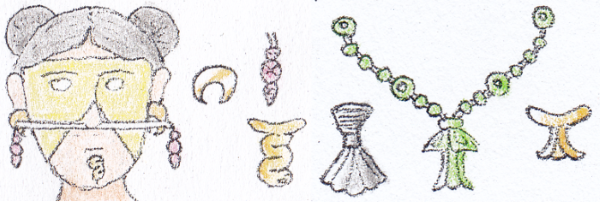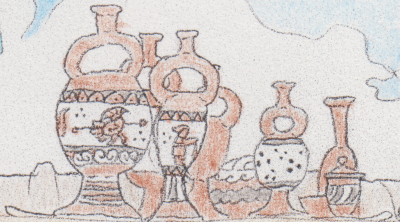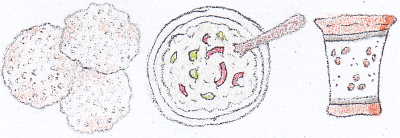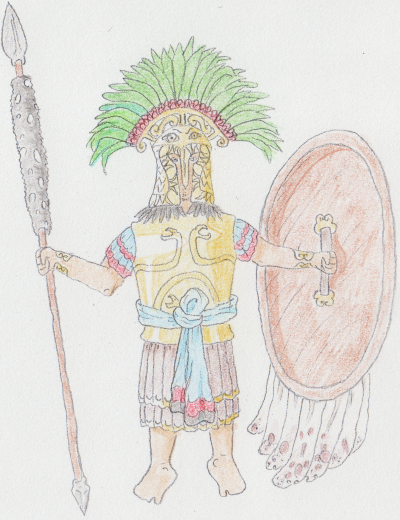Pakrans
Pakric: Pakrú /phaːkhruː~pʼaːkhruː/
Rexlas: Pakrei /phaːkhreiː/
Húlpakric: Pakrö /phaːkhrœː/
Dalran: Pakrere /phaːkhrɛːrɛː/
The pakrans1 are native to the Ajómax Rainforest along the northeastern coast of Úrtal Sea in southwestern Laxilþía, between Móþon Lake and Katark Mountains to the north and the Kalis Swamp to the south. Their traditional territory forms the province of Pakróalx in the northwestern empire of Resak.
Pakran hegemony began to wane with the rise of Dalra in Emlas, particularly when the pakran colonies there were integrated into the new empire, though the inhabitants didn't really mind.
The pakrans were (and still are) far from unified people, though they share a common culture, and their city-states were at war with each others just as often as against the enans and other neighbouring cultures. The only exception to this was during the reign of Pakalos, a king from Banúþra on the shores of Móþon Lake, who managed to briefly unify the pakrans under his banner in order to liberate the colonies and defeat the Dalrans.
Pakalos' journey didn't go quite as he expected; his massive fleet was scattered in as storm and the colonists (now known as Húlpakrans) had little interest in rejoining the pakrans. Pakalos then gathered what was left of his army and launched an attack on the dalrans and, despite being outnumbered and lacking reinforcements, proved surprisingly successful to begin with.
However, at a critical moment the dalrans, inspired by the sight of a double rainbow over the battlefield, proved victorious and captured Pakalos.
His demise has become the stuff of legends, as no one's sure what exactly happened, but news of his Pakalos' defeat marked the end of unity among pakrans, who continued squabbling for land and resources as before. Eventually, they were conquered by the Rexans.
Long hair is preferred, sometimes divided into dreadlocks or, especially for women, tied into one or two buns. Jewelry is popular, especially by wealthier pakrans, and combines native pakran, rexan and even dalran styles.
Mead (bilixú) and wine are commonly drunk by pakrans, and unlike the rexans there's little taboo for revelry in public, especially during religious festivals as inebriation is believed to bring people closer to the gods, and also helps dull the pain during bloodletting rituals. Cacao is also consumed during ceremonies.
Unlike rexans, pakrans generally prefer offering their own blood to the gods rather than sacrificing people, though the latter is practiced to some extend along with more common animal sacrifices, offerings of food, drink, incense and flowers. Bloodletting is mostly practiced by men by pricking their earlobes, nose or tongue and letting the blood drip on cotton strips, and is part of their coming-of-age ceremony.
Dalix, also known as Talx, is a god of war and hunting. Before the rexans, pakrans traditionally sacrificed defeated defeated kings and captured warriors to him, and in some cities an oracle of Dalix chooses someone each year to be offered to the god.
Ekrelú, known as Mokrú in the east, is the main fertility goddess of the pakrans, associated with agriculture and the underworld.
Divine twins associated with warfare and woodlands, to whom ancient pakran kings traced their lineage.
Also known as Jóxa or Kasas, Joxas is a god of rain, thunderstorms and droughts. He's depicted holding a thunderbolt and with a distinct crown on his head.
Olfú is the god of music and healing, and plagues.
Zoníox is the goddess of love, mead (and by extension, bees), drunkenness and insanity.
The pakrans1 are native to the Ajómax Rainforest along the northeastern coast of Úrtal Sea in southwestern Laxilþía, between Móþon Lake and Katark Mountains to the north and the Kalis Swamp to the south. Their traditional territory forms the province of Pakróalx in the northwestern empire of Resak.
History
Originally subjects of the ancient Memnans during bronze age, the pakrans were one of the first cultures to establish their own civilization in Laxilþía after their downfall. For a time, they founded a number of colonies and were the dominant culture along the coast of Úrtal Sea and northern Akral Sea along with their rivals, the Enans from Emlas to the west.Pakran hegemony began to wane with the rise of Dalra in Emlas, particularly when the pakran colonies there were integrated into the new empire, though the inhabitants didn't really mind.
The pakrans were (and still are) far from unified people, though they share a common culture, and their city-states were at war with each others just as often as against the enans and other neighbouring cultures. The only exception to this was during the reign of Pakalos, a king from Banúþra on the shores of Móþon Lake, who managed to briefly unify the pakrans under his banner in order to liberate the colonies and defeat the Dalrans.
Pakalos' journey didn't go quite as he expected; his massive fleet was scattered in as storm and the colonists (now known as Húlpakrans) had little interest in rejoining the pakrans. Pakalos then gathered what was left of his army and launched an attack on the dalrans and, despite being outnumbered and lacking reinforcements, proved surprisingly successful to begin with.
However, at a critical moment the dalrans, inspired by the sight of a double rainbow over the battlefield, proved victorious and captured Pakalos.
His demise has become the stuff of legends, as no one's sure what exactly happened, but news of his Pakalos' defeat marked the end of unity among pakrans, who continued squabbling for land and resources as before. Eventually, they were conquered by the Rexans.
Culture
Apparel
Pakran clothing is made almost exclusively out of cotton, with men usually wearing either some combination of loincloth, short, sleeveless tunic and cloak (common on the lowlands) or wrapping a cloak around them as makeshift belted tunic (prevalent in the highlands), while women wear dresses similar to those used by rexans. Footwear is uncommon, mostly worn by goatherds, hunters and riders, while headbands and turbans of sorts are worn by most people.Long hair is preferred, sometimes divided into dreadlocks or, especially for women, tied into one or two buns. Jewelry is popular, especially by wealthier pakrans, and combines native pakran, rexan and even dalran styles.
Art
Architecture
Traditional pakran architecture is characterized by the use of stone (sometimes marble and jade) and corbeled arches, especially for monumental structures, city walls and gates. All but the smallest shrines are built atop stepped pyramids of different styles depending on the region, and are generally brightly painted, gilded and adorned with sculptures of all sorts.Music
Music is an important part of pakran culture, featured in anything from celebrations to religious rites to funerals and, traditionally, warfare. Common instruments include drums and slit drums, flutes and reed pipes, rattles and lyres.Pottery
Pakran pottery has long been highly sought after in various countries in Laxilþía, Emlas and even distant Túlmikkía, especially ones painted with scenes from mythology, history and daily life. It's usually brown and painted in black and white or, more rarely, black with white decorations; the latter is influenced by the Orrólans of northwestern Túlmikkía.Cuisine
Pakran food is infamously bland, due to longstanding belief that anything remotely fancy is a sign of decadence. It consists mostly of bread, cheese, bell peppers, avocado (dáx), goat meat and olive oil, with fish and octopus common in the west while deer and tapirs are more prevalent in the east. Salt and sesame seeds are the main spices, though some also enjoy mint and chili, both introduced by the rexans.Mead (bilixú) and wine are commonly drunk by pakrans, and unlike the rexans there's little taboo for revelry in public, especially during religious festivals as inebriation is believed to bring people closer to the gods, and also helps dull the pain during bloodletting rituals. Cacao is also consumed during ceremonies.
Religion
Like most people in Laxilþía (and Gætíus' World in general), pakrans practice polytheism, with numerous local deities worshipped in different regions, towns and cities along with a few gods and goddesses whom all pakrans celebrate during major festivals. Dances are important part of certain rituals, especially to the east.Unlike rexans, pakrans generally prefer offering their own blood to the gods rather than sacrificing people, though the latter is practiced to some extend along with more common animal sacrifices, offerings of food, drink, incense and flowers. Bloodletting is mostly practiced by men by pricking their earlobes, nose or tongue and letting the blood drip on cotton strips, and is part of their coming-of-age ceremony.
Major deities
Dalix
Dalix, also known as Talx, is a god of war and hunting. Before the rexans, pakrans traditionally sacrificed defeated defeated kings and captured warriors to him, and in some cities an oracle of Dalix chooses someone each year to be offered to the god.
Ekrelú
Ekrelú, known as Mokrú in the east, is the main fertility goddess of the pakrans, associated with agriculture and the underworld.
Gróaxalos and Mogrix
Divine twins associated with warfare and woodlands, to whom ancient pakran kings traced their lineage.
Joxas
Also known as Jóxa or Kasas, Joxas is a god of rain, thunderstorms and droughts. He's depicted holding a thunderbolt and with a distinct crown on his head.
Olfú
Olfú is the god of music and healing, and plagues.
Zoníox
Zoníox is the goddess of love, mead (and by extension, bees), drunkenness and insanity.
Funerary rites
Burial is the norm among the pakrans, and the soul is believed to go on a perilous journey before it reaches the underworld. Unlike rexans, pakrans generally fear death, for they believe the afterlife to be cold, dark and generally unpleasant.1Original icelandic: Pakrar, singular: Pakri
Diverged ethnicities
Related Locations


















Comments